Flag of Poland
 | |
| Flag of the Republic of Poland | |
| Use | National flag |
|---|---|
| Proportion | 5:8 |
| Adopted | 1919 |
| Design | A horizontal bicolor of white and red |
| Flag with coat of arms of the Republic of Poland | |
 | |
| Use | Civil and state flag, civil and state ensign |
| Proportion | 5:8 |
| Adopted | 1919; last modified 1990 |
| Design | A horizontal bicolor of white and red defaced with the arms of Poland in the white stripe |
The flag of Poland is a rectangular piece of cloth in the national colors arranged in two horizontal stripes of equal width, the upper one white and the lower one red. The two colors are defined in the Polish constitution as the national colors. Two variants of the flag exist, with and without the national coat of arms in the middle of the white stripe. The defaced variant, that is the one with the coat of arms, is legally reserved for official use abroad and at sea. The Polish navy uses a similar flag, with an addition of two swallow tails.
The national colors are of heraldic origin and derive from the tinctures (colors) of Polish and Lithuanian coats of arms. White and red were officially adopted as national colors in 1831. The national flag was officially adopted in 1919. Since 2004, Polish Flag Day has been celebrated on May 2.
Design
Legal sources

The colors and flags of the Republic of Poland are described in two legal documents: the Constitution of the Republic of Poland of 1997,[1] and the Coat of Arms, Colors and Anthem of the Republic of Poland, and State Seals Act (Ustawa o godle, barwach i hymnie Rzeczypospolitej Polskiej oraz o pieczęciach państwowych) of 1980 with subsequent amendments[2] (henceforth referred to as "the Coat of Arms Act").
The legislation concerning the national symbols is far from perfect. The Coat of Arms Act has been amended a number of times and refers extensively to executive ordinances, some of which have never been issued. Moreover, the Act contains errors, omissions and inconsistencies which make the law confusing, open to various interpretations and often not followed in practice.[3]
National colors
According to Chapter I, Article 28, paragraph 2 of the Constitution, the national colors of Poland are white and red.[1]. The Coat of Arms Act, Article 4, further specifies that the colors are white and red in two horizontal, parallel stripes of equal width, of which the top one is white and the bottom one is red.[2]
| Color[4] | x | y | Y | ΔE | |
|---|---|---|---|---|---|
| White | 0.315 | 0.320 | 82.0 | 4.0 | |
| Red | 0.570 | 0.305 | 16.0 | 8.0 | |
| Illuminant C, measurement geometry d/0 | |||||
The same article further specifies that if the colors are displayed vertically, the white stripe is placed on the left from the onlooker's viewpoint. Attachment no. 2 to the Act shows the national colors in both horizontal and vertical alignment, as well as coördinates of both colors in the CIE 1976 color space.
Variants of the national flag
The Constitution contains no mention of a national flag. It is defined by the Coat of Arms Act which specifies two variants of the national flag: the national flag of the Republic of Poland (flaga państwowa Rzeczypospolitej Polskiej) and the national flag with coat of arms of the Republic of Poland (flaga państwowa z godłem Rzeczypospolitej Polskiej). Both flags are defined in Article 6 of the act as follows:

- The state flag of the Republic of Poland is a rectangular piece of cloth in the colors of the Republic of Poland hoisted on a flagpole.
- The state flag of the Republic of Poland is also the flag specified in paragraph 1, with the coat of arms of the Republic of Poland placed in the middle of the white stripe.[2]
The hoist to fly ratio for both flags is 5:8. For the latter flag, the proportion between the inescutcheon of the coat of arms and the hoist is 2:5. Images of both variations of the flag can be found in attachment no. 3 to the Coat of Arms Act.
Usage
Respect for the flag
Polish law says that treating the national symbols, including the flag, "with reverence and respect" is the "right and obligation" of every Polish citizen and all state organs, institutions and organizations.[2] Public disrespect, destruction or violent removal of the flag is considered a crime punishable by "a fine, limitation of freedom [penal servitude] or up to one year of deprivation of freedom [imprisonment]".[5] Official statistics show that crimes against national symbols are rare: 43 such crimes in 2003 and 96 in 2004 were less than 0.001% of all crimes registered in Poland in those years.[3]
Who may and who is required to fly the flag
According to the Coat of Arms Act, everyone can use the Polish flag, especially during national and cultural events, as long as it is done in a respectful manner.[2] This liberty in the use of national colors is a relative novelty. Until 2004, Polish citizens were only allowed to fly the Polish flag on national holidays. Unauthorized use of national symbols was illegal and flying the flag with coat of arms was, from 1955 until 1985, punishable by a fine or arrest for up to one year.[3] This restriction and kind of state monopoly on the use of national symbols during the Communist regime made flying the Polish flag a symbol of resistance against the government. It became customary – and still is – for workers to hoist Polish flags on plant buildings when going on strike. This is why the Polish flag, as a symbol of patriotism and resistance against the Communist rule, is part of the Solidarity trade union logo.[6]

Flag without coat of arms
Organs that are required by law to fly the national flag without coat of arms on or in front of their official buildings are:
- the Sejm (lower house of parliament);
- the Senate (upper house of parliament);
- the President of the Republic;
- the Council of Ministers (cabinet) and the President of the Council of Ministers (Prime Minister);
- local legislatures – only during their sessions;
- other state and local government organs – only on national holidays.
Additionally, the national flag without coat of arms is used as an ensign for inland navigation.[2]
Flag with coat of arms
While the ban on using the flag without coat of arms has been lifted, the use of the national flag with coat of arms is still legally restricted. This flag should be only flown:
- on or in front of Polish embassies, consulates and other representative offices and missions abroad, as well as by Polish ambassadors and consuls on their residences and vehicles;
- at civilian airports and heliports;
- on civilian airplanes – only during international flights;
- on buildings of seaport authorities;
- as a merchant (civil) ensign.[2]
In practice, however, this restriction is often ignored and the two flags – with and without coat of arms – are treated as interchangeable.[3] The variant with the coat of arms is particularly often used by the Polonia, or Polish diaspora outside Poland, especially in the United States.[7]
Flag flying days
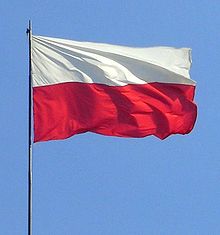
State and local government organs are legally required, and other institutions and organizations as well as all citizens are encouraged to fly the Polish flag on the following days:
- May 1 – State Holiday (May Day);
- May 2 – Polish Flag Day;
- May 3 – Constitution Day;
- November 11 – Independence Day.
Polish Flag Day (formally: Flag of the Republic of Poland Day, Dzień Flagi Rzeczypospolitej Polskiej) was first observed on May 2, 2004. It was established in order to educate the Polish people about the history and significance of national symbols.[8] The date was chosen to coincide with the Polonia Day traditionally observed by Polish diaspora outside Poland and the Polish Senate on May 2. There was also a practical reason: since May 2 is already a day between two mandatory flag flying days, it allows for the flag to be flown continuously for three consecutive days. Unlike May Day and Constitution Day, it is not a public holiday, although making a bridge, i.e. taking a day off on that day is common practice (see Holidays in Poland).
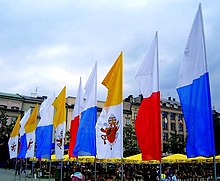
Other days when the Polish flag is often flown on official buildings include:
- May 5 and May 9 – Europe Days (together with the European flag);
- August 15 – Polish Armed Forces Day (mostly on military premises and at tombs of the Unknown Soldier)
- September 27 – Polish Underground State Day.
The flag is also popularly flown during important sporting events, such as the FIFA World Cup, if Polish athletes are participating; and during an official visit of a particularly important person, especially a pope, in Poland. During a pope's visit, the national flag is usually flown together with yellow and white Church flags, and white and blue Marian flags. It is not common to fly the national flag on personal occasions, such as birthdays or weddings.
According to polls, about one out of three Poles say they own a Polish flag, and about one out of four fly it on national holidays. Such public display of patriotism is much more common in western Poland, especially in Greater Poland, than in other parts of the country.[3]
Flag protocol
Apart from the obligation to treat the flag with due respect, Polish law does not offer a detailed flag protocol. Some organizations and public institutions, such as the Heraldic and Vexillological Institute[9] and the Supreme Chamber of Control[3] have proposed flag protocols for the Polish flag, based on custom, flag protocols of other countries such as India and the United States, and common sense. These protocols, however, are not legally binding.
Standards of respect
- The flag should never be dipped to any person or thing.[9]
- The flag should never have placed on it any mark, letter, word, number or drawing of any kind.[3][9]
- The flag should never touch the ground, floor or water beneath it.[3][9]
- The flag should be secured from being torn off or falling to the ground. It should not be flown outdoors during a heavy rain, blizzard or very strong wind.[3][9]
- The flag should never be dirty, torn or faded. When no longer in a fit condition to be used, the flag should be disposed of in a dignified manner, preferably by cutting it in half so as to separate the colors[3] and then, burning.[9]
Correct display
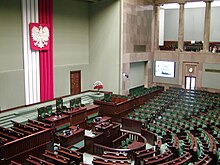
- A single specimen of the flag on or in front of a public office building serves an informative purpose – it indicates the building's official role. Multiple flags serve a decorative purpose and should only be used to mark special occasions, such as national holidays.[3]
- The flag should be raised before 8 a.m. and lowered at sunset. If it is flown at night, it should be illuminated.[3]
- During a ceremonial raising of the flag, the national anthem is played. Timing of the raising should match the duration of the anthem.[9] Civilians pay respect by standing in a dignified manner; additionally, men uncover they heads. Members of uniformed services stand at attention. If their uniform includes headgear and they are not standing in an organized group, they also perform the two-finger salute. Color guards dip their banners to the flag.[2] (See video)
- In Polish heraldry, the tincture of the charge has priority in relation to the tincture of the field. In the case of Polish national colors, white, the color of the White Eagle, should always be placed in a more honorable position than red, the color of the field of the Polish coat of arms.
- If the flag drapes a coffin, the white stripe should be placed over the heart.[9]
- If the flag is hung vertically above a street, the white stripe should be placed on the left when looking in the direction of increasing house numbers.[9]
With other flags

- When displayed with other flags, each flag must be flown from a separate pole of the same height.[3]
- The Polish flag should be raised first and lowered last.[3]
- The Polish flag should be always placed in the most honorable position.[3]
- The order of precedence for flags is as follows:[9]
- flag of Poland,
- national flags of other countries (in alphabetical order),
- voivodeship flags,
- county flags,
- commune flags,
- European flag,
- flags of domestic organizations,
- flags of international organizations,
- public services flags,
- corporate flags,
- other flags.
National mourning
The President of the Republic may announce a period of national mourning. During that time Polish flags are flown at half-staff.[2] If a flag is flown from a wooden pole rather than a staff or mast, a black ribbon is attached to the pole as a sign of mourning or a black flag is flown to its left from the national flag.[3]
History
Royal banner
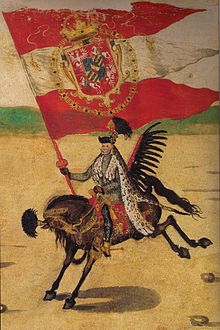
The earliest vexilloids (flag-like objects) used in Poland were known as stanice and probably resembled the Roman vexillum, that is a cloth draped vertically from a horizontal crosspiece attached to a wooden pole or spear. They served as both religious and military symbols as early as 10th century CE. With Poland's conversion to Christianity in 966, the stanice were probably Christianized by replacing pagan symbols with Christian ones. The royal banner of arms dates back to the reign of King Boleslaus the Generous (1076-1079), but it was during the reign of King Ladislaus the Elbow-High (1320–1333) that a red cloth emblazoned with the White Eagle of the arms of Poland was finally established as the Banner of the Kingdom of Poland, a symbol of royal authority used at coronations and in battles.[10]
In the times of the Polish-Lithuanian Commonwealth (1569-1795), a banner of the Commonwealth was also used, combining the heraldic symbols of Poland and the Grand Duchy of Lithuania. The Commonwealth banner was initially plain white emblazoned with the arms of the Commonwealth which consisted of the heraldic charges of Poland (White Eagle) and Lithuania (Pursuer). Since both Polish and Lithuanian coats of arms consisted of white (Argent) charges in a red (Gules) field, these two colors started to be used for the entire banner. During the 17th century, the banner was usually divided into three or four horizontal, often swallow-tailed, stripes of red and white.[10]
National cockade
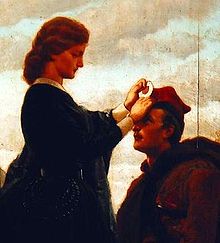
In the 18th and 19th centuries, European nations used cockades, or knots of colored ribbons pinned to the hat, to denote the nationality of their military. In Poland, until 1831, there was no consensus as to what the colors of the national cockade should be. Polish soldiers wore white, white-and-red, blue-and-red or blue-white-red cockades.
The custom came to Poland from Saxony during the reign of Augustus II (1697-1733), King of Poland and Elector of Saxony. During that time, the cockade worn by the Polish military had, like in Saxony, the form of a white silk ribbon with a knot in the middle. It was later replaced with a circular white cockade wrinkled toward the center, patterned after the cockade of the Kingdom of France. During the reign of King Stanislaus Augustus (1764-1795), a white-and-red cockade came into use alongside the plain white one. In 1791, the Military Commission introduced a metal cross pattée as a more durable alternative to the cockade. However, many soldiers continued to either pin the cross to the cockade or wear the cockade without the cross. Polish military leaders and national heroes of the time, such as General Tadeusz Kościuszko and Prince Józef Poniatowski pinned plain white "national" cockades to their hats.[10]

The patriotic and staunchly Catholic members of the Bar Confederation of 1768-1772 adopted crimson – the symbol of Polish szlachta, or nobility – and blue – symbolizing Virgin Mary – as their colors. These, as well as white-and-red, were considered national colors during the Great Sejm of 1788-1792. White and red were first publicly used as national colors by civilians on 3 May 1792 in Warsaw, during a celebration of the first anniversary of the adoption of the Constitution of 1791. Meanwhile, the political left wore the blue-white-red cockades of the French Revolution. Polish Legions created in 1791 in French-controlled republics in Italy, used either the French tricolor cockade or national cockades of the particular Italian republics in which they served. The military of the French-controlled Duchy of Warsaw (1807-1815) and the Russian-controlled Congress Kingdom of Poland (1815-1831) used the white cockade, which was also worn by the cadets who started the November Uprising against Russian rule on 29 November 1830.[10]
During the uprising, the Sejm realized the need for unified national insignia that could be used by the Polish military. On 7 February 1831 it adopted white and red, the tinctures (colors) of the Polish and Lithuanian coats of arms, as the national cockade of Poland. The white-and-red cockade was henceforth worn by Polish soldiers in the November Uprising, as well as by participants of the Kraków Uprising of 1846, Polish freedom fighters in the Grand Duchy of Posen and the Austrian Empire during the Spring of Nations of 1848, and Polish insurgents during the January Uprising of 1863-1864. White and red colors were also used by civilians to show their protest against the Russian rule, as well as by people in France, Britain, Germany, Belgium and other countries as a sign of their sympathy with the Polish cause. The Sejm's decision was not, however, immediately accepted by all. Left-wing politicians of the time, such as Joachim Lelewel, continued to regard the revolutionary blue, white and red as true national colors. Tricolor standards were used by some Polish guerrilla units during the January Uprising.[10]
Twentieth century

White-and-red flags were first waved during a patriotic demonstration on 3 May 1916 in Warsaw. The organizing committee advised participants about the correct alignment of the colors, that is with the white stripe above the red one. Still, many demonstrators brought flags with the red stripe on top. On 1 August 1919, almost a year after Poland regained independence in November 1918, the Sejm officially introduced a white-and-red bicolor as the Polish national flag. In order to avoid confusion with the white-and-red maritime signal flag used internationally by harbor pilots and tugboats, the same act of Sejm introduced a variant of the flag with the coat of arms in the white stripe for use as a civil ensign and by Polish diplomats and consuls abroad.[10]
Apart from changes in the legal specifications of the shades of the national colors (see the section below), the basic design of the Polish flag, including the 5:8 ratio, has remained unchanged to this day. The flag with coat of arms was only modified to adjust to the changes in the coat of arms itself. Major modifications included a change in the stylization of the eagle from Classicist to Baroque in 1927 and the removal of the crown from the eagle's head during the Communist rule from 1944 to 1990.

20th-century Polish insurgents wore white-and-red brassards (armbands) which played a role similar to the cockade of the previous centuries. Such armbands were worn by Polish freedom fighters during the Greater Poland Uprising (1918-1919) and Silesian Uprisings (1919-1921), as well as during the Second World War (1939-1945) by the soldiers of the Home Army (AK) and Peasants' Battalions (BCh) – usually defaced with the acronyms of their formations.[10]
During the Second World War, Polish soldiers raised the Polish flag on several sites of their victories. On 18 May 1944, after an Allied victory over the German forces in the Battle of Monte Cassino, a patrol of the 12th Podolian Uhlan Regiment (part of the Polish 3rd Carpathian Rifle Division) raised a Polish flag on the ruins of the Monte Cassino abbey in Italy. On 1 August 1944, the first day of the Warsaw Uprising, a white-and-red flag was hoisted on the Prudential building, Warsaw's tallest skyscraper of the time. During the liberation of Warsaw by Soviet forces and Polish People's Army on 17 January 1945, Polish flags were raised on the Belvedere palace and the ruins of the Main Railway Station. On 2 May 1945, after the capture of Berlin, soldiers of the 7th Battery, 3rd Division, 1st Light Artillery Regiment planted Polish flags on the Berlin Victory Column.[10]
Polish flags were also used by anti-government demonstrators under the Communist rule. During the bloody riots of 1956 in Poznań and 1970 in Gdańsk, protesters carried flags that were blood-stained on the white stripe.[10]
Shades of red
| Shades of red comparison | |
|---|---|
| Crimson | |
| Amaranth | |
| Vermilion | |
| Current statutory[4] | |
| HTML red | |
Until 1928, the exact shades of the national colors were not legally specified. In practice, the actual hue, particularly of red, depended on what kind of red dye was available. In pre-partition Poland, crimson, due to its high price, was a color associated with the rich and the privileged. It could be obtained from the domestically harvested Polish cochineal, although imported alternatives were also available: kermes from the Mediterranean Basin (hence karmazyn, the Polish name of the color) and Mexican cochineal after the discovery of the New World. Crimson was reserved for the nobility and considered a symbol of the aristocracy, so that karmazyn became synonymous with a magnate. A royal ban on wearing this color could be a form of punishment; in the 14th century, the Nałęcz clan of Greater Poland were forbidden to dress in crimson for their ancestors' complicity in the assassination of King Premislaus in 1296.[10] In the first half of the 19th century, due to the influence of French fashion, crimson was largely replaced with the cheaper amaranth.
The National Cockade Act of 1831 did not specify the shade of red, for which it was criticized by Joachim Lelewel,[10] nor did the Coat of Arms and National Colors Act of 1919. In 1921, the Ministry of Military Affairs issued a pamphlet with illustrations of the Polish flag and other national symbols which used the crimson shade of red.[11] The pamphlet was not, however, an official source of law and was published for informative purpose only. The shade of red was first legally specified by a presidential decree of 13 December 1928 which stipulated that the official shade is vermillion. This specification was upheld by a decree of 7 December 1955.[10] The verbal prescription was replaced with coördinates in the CIE 1976 color space by the Coat of Arms Act of 31 January 1980,[2] bringing the resulting hue closer to crimson again.
Related and similar flags
 |
 |
 |
 |
The flag of the Grand Duchy of Posen, a Polish-populated autonomous province of the Kingdom of Prussia created in 1815, was a red-and-white horizontal bicolor. Its colors were taken from the duchy's coat of arms which consisted of the Prussian Black Eagle with an inescutcheon of the Polish White Eagle. With Germany's increasingly anti-Polish policy and a rising identification of white and red as Polish national colors, the red-and-white flag of Posen was replaced in 1886 with a white-black-white horizontal triband.[12] No other part of Poland during the time of Partitions used a flag that would incorporate Polish national colors.
 |
 |
 |
 |
Today, many flags used in Poland are based on the design of the national flag. This applies especially to flags defined by Polish law and used by the Polish military and other uniformed services, such as the naval ensign – a swallow-tailed horizontal bicolor of white and red defaced with the arms of Poland in the white stripe. Flags of some administrative subdivisions also resemble the national flag. Examples include the flag of the Lower Silesian Voivodeship – a horizontal bicolor of white and red defaced with the arms of the voivodeship – or the flag of the Lesser Poland Voivodeship – a horizontal tricolor of white, yellow and red with the yellow stripe half as wide as any of the other two.
Due to the horizontal bicolor being a relatively simple and widespread flag design, and white and red being the most popular colors used on flags,[13] there are many flags worldwide that are similar or near identical to the flag of Poland despite being unrelated to it. For example, the little used flag of Bohemia, the major historical region of Poland's southern neighbor, the Czech Republic, consists of two horizontal stripes, white on top and red on bottom. Similarly to the flag of Poland, it is of heraldic origin, the coat of arms of Bohemia being Gules, a lion rampant, queue fourchée Argent, crowned, langued and armed Or, that is a silver double-tailed lion in a red field. The white-and-red Bohemian flag came into use when Bohemia was a province of Austria-Hungary and, after the end of the First World War in 1918, it was shortly used as a flag of the newly formed Czecho-Slovak Republic. In 1920, in order to avoid confusion with the Polish flag, a blue triangle was added to create a flag used by Czechoslovakia until its dissolution in 1993 and currently used as the flag of the Czech Republic.[14]
Other examples of flags that could be confused with the Polish one include the civil flags of the following regions: Kranj, Slovenia; Thuringia, Germany; Upper Austria and Tyrol, Austria; as well the city of Honda, Colombia. There are currently two independent states – Indonesia and Monaco – whose national flags are horizontal bicolors of red and white, and therefore may be described as the Polish flag in distress (upside down), save for the differences in proportions and shades of the colors (see Flag of Indonesia and Flag of Monaco).
References
- ^ a b Template:Pl icon Konstytucja Rzeczypospolitej Polskiej [Template:En icon Constitution of the Republic of Poland], Dz.U. 78.483.1997
- ^ a b c d e f g h i j k Template:Pl icon Ustawa o godle, barwach i hymnie Rzeczypospolitej Polskiej oraz o pieczęciach państwowych [Coat of Arms, Colors and Anthem of the Republic of Poland, and State Seals Act], Dz.U. 05.235.2000
- ^ a b c d e f g h i j k l m n o p Template:Pl icon Najwyższa Izba Kontroli, Informacja o wynikach kontroli używania symboli państwowych przez organy administracji publicznej [Supreme Chamber of Control, Information about the results of the control of state symbols usage by organs of public administration], Warsaw, April 2005
- ^ a b Statutory color specifications rendered into sRGB for web display, assuming the white point as 6500K. The resulting RGB values, in hexadecimal notation, are: white E9E8E7 and red D4213D. Note that the shades actually visible on you screen depend on your browser and screen settings, as well as the surrounding context and other factors. An intensely luminous light background may make the statutory white color appear gray. Also note that most websites which display the Polish national colors use a simplified approximation of the legally specified shades by using basic HTML colors: white FFFFFF and red FF0000 (see the official website of the President of the Republic of Poland for an example).
- ^ Template:Pl icon Kodeks karny [Penal code], Dz.U. 88.553.1997
- ^ Template:En icon Niezabitowska, Małgorzata (January), "Discovering America", National Geographic, p. 48
{{citation}}: Check date values in:|date=and|year=/|date=mismatch (help) - ^ Template:Pl icon "Flaga". Official website of the President of the Republic of Poland. Chancellery of the President of the Republic of Poland. Retrieved 2007-09-30.
- ^ Template:En icon "Polish Flag's Day - The Origins". Polish Ministry of National Defense. 2007. Retrieved 2007-11-24.
- ^ a b c d e f g h i j k l Template:Pl icon "Protokół flagowy – Jak postępować z flagami". Instytut Heraldyczno-Weksylologiczny. 11 July 2005. Retrieved 2007-09-30.
{{cite web}}: Check date values in:|date=(help) - ^ a b c d e f g h i j k l Template:Pl icon Znamierowski, Alfred (1995). Stworzony do chwały. Warsaw: Editions Spotkania. p. 299. ISBN 83-71-15055-5.
- ^
Template:Pl icon Template:Fr icon Stanisław Łoza (1921). Godło i barwy Rzeczypospolitej Polskiej – Armoiries et couleurs de la République Polonaise [Coat of Arms and Colors of the Republic of Poland]. Warsaw: Ministry of Military Affairs. p. 10.
{{cite book}}: Unknown parameter|coauthors=ignored (|author=suggested) (help) - ^ Template:En icon "Grand Duchy of Posen 1815-1849, Posen Province 1849-1920 (Prussia, Germany)". Flags of the World. Retrieved 2007-11-02.
- ^ Template:En icon "Colors of Flags". Flags of the World. Retrieved 2007-11-04.
- ^ Template:En icon "Bohemia (Czech Republic)". Flags of the World. Retrieved 2007-11-02.

